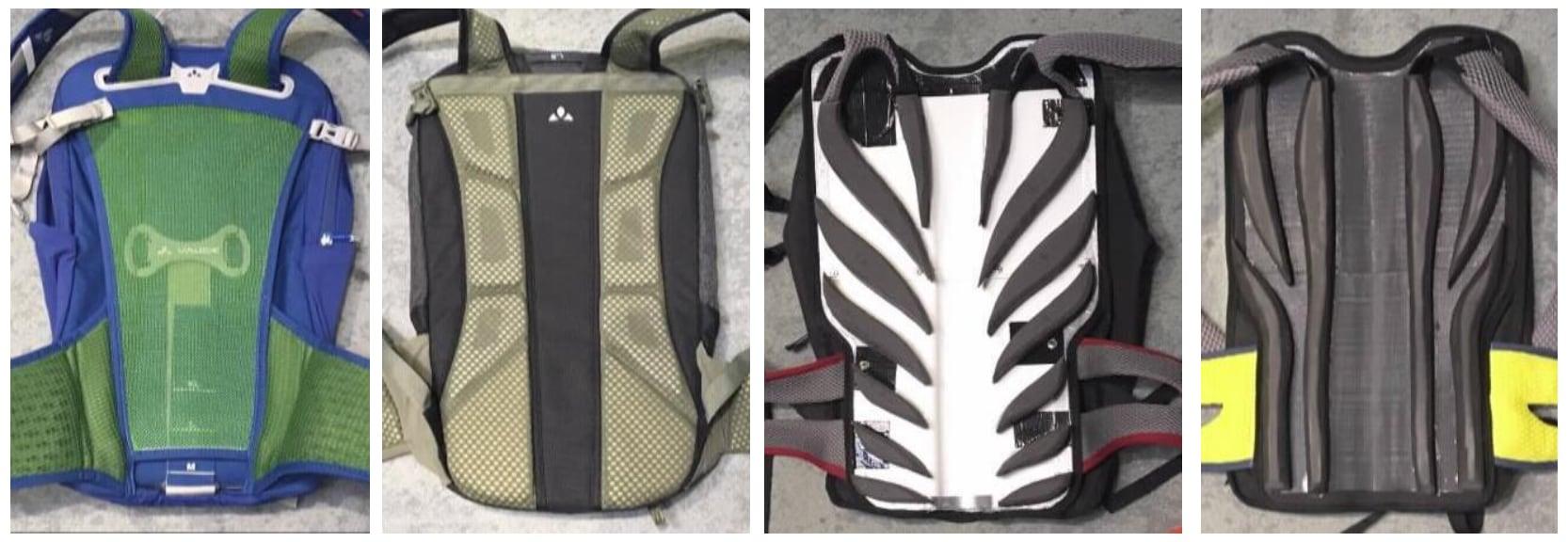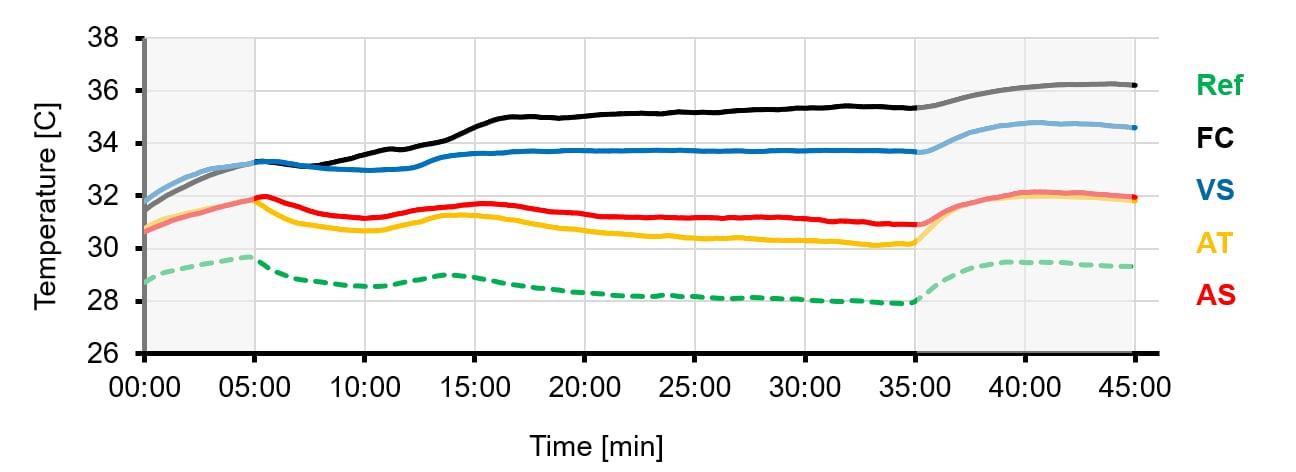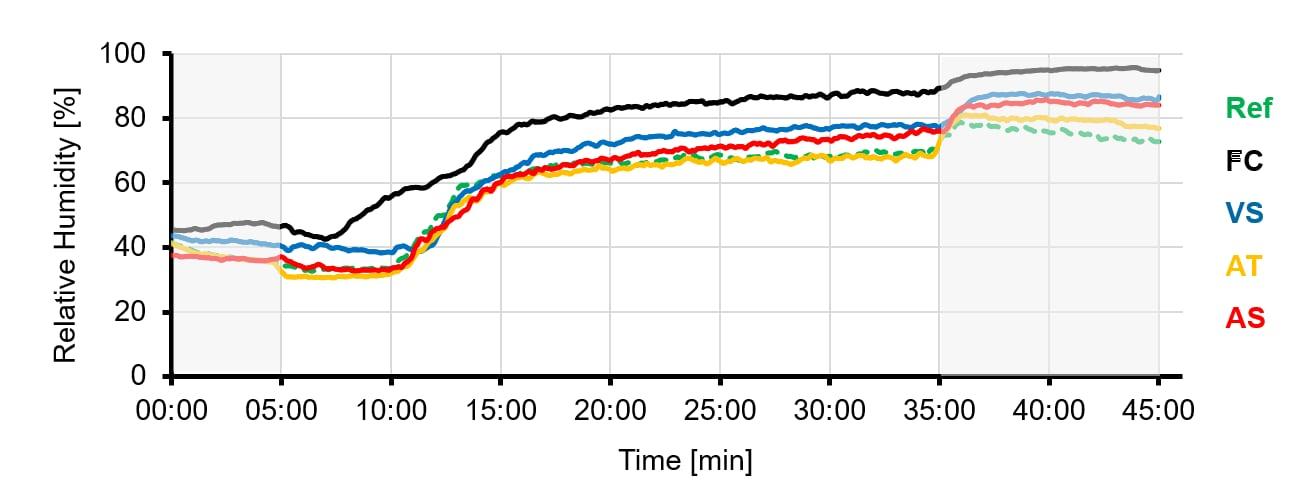Influence of an engineered backpack ventilation technology on thermal comfort during cycling – A pilot study
Frank I. Michel1, Nils Schneider1/2, Markus Lachner1/2, Robert Klauer1, Frank Emrich2, Wouter Remmerie2
1 VAUDE Sport GmbH &Co KG, i-team, Germany (www.vaude.com)2 German Sport University Cologne, Institute of Biomechanics and Orthopaedics, Germany 3 AirShaper, Antwerp, Belgium
Introduction
Thermoregulation in sports is an essential aspect for performance as well as thermal comfort (Ückert 2012) especially in endurance sports such as cycling. During many cycling activities backpacks are worn. However, wearing a backpack affects the microclimate (MC: temperature and humidity between skin and first clothing layer) as well as the interlayer climate (ILC: temperature and humidity between first clothing layer and backpack/mid layer) depending on the backpack sytem. Conventional ventilated backpack systems (Fig. 1) reduce the MC and ILC compared to full contact backpacks (Klauer et al. 2018). Two new rear panel designs for cycling backpacks were developed and evaluated using CFD analysis. The present subject study represents a “proof of concept” comparing two new rear panel designs with a conventional full contact back (FC) and a ventilated backpack system (VS) regarding temperature and humidity related to MC and ILC.

Material & Method
Four male sport students (ϕ25 years; ϕ184cm; ϕ76kg) participated in the pilot study. They performed a load profile of 30min. cycling on a Tacx cycling trainer at a moderate intensity level of 130W (Heart frequency: ϕ116 bpm) with 5min. rest prior and 10min. rest after the cycling part. The subjects were tested in a climate chamber at 20±1°C and 38±2% relative humidity. Four floor fans were positioned in front of the cyclist generating an airflow aimed at the ventral torso of the cyclist (Fig. 2).

The air velocity around the shoulder region was 9kmh-1. During cycling the subjects had to maintain a sagittal torso angle of approx. 50°. Temperature and humidity were measured with combi sensors (SHT25, Sensirion, Switzerland) and stored with a mobile data logger (MSR147WD, MSR Electronics GmbH, Switzerland) for both MC and ILC. According to Klauer et al. (2018) the sensors were attached along the spine region on the skin of the subject (MC) and the rear panel of the backpack (ILC) (Fig. 2). Each subject had to cycle with all 4 backpack conditions in a randomized order (Fig. 3) including a reference condition (Ref) without a backpack.

Results
The results of the pilot study clearly demonstrate the improved thermo- physiological response of the AirTurbulencer (AT) and AirStreamer (AS) concept compared to the VS and FC systems regarding both MC and ILC (Fig. 4 and 5; Tab. 1).


By wearing a regular backpack, the convective heat transfer on the back is limited. The conventional VS system enhances the convective heat transfer compared to a regular backpack system. However, the AS and AT prototypes feature a further decrease in temperature and relative humidity compared to VS. This is valid for both MC and ILC. The data points to a slightly better convective heat transfer for the AT compared to the AS concept.

Discussion & Conclusion
So far, there is little research on thermal comfort when wearing a backpack while cycling. Klauer et al. (2018) applied a similar study setup and investigated similar test conditions (Ref, FC, VS). However, the exercise intensity was slightly higher, and they did not use fans to generate headwind. The temperatures of MC for the FC and VS condition are slightly higher in the study done by Klauer et al. (2018) compared to the present data. This can lead to the assumption that the headwind - depending on the backpack design - really affects the convective heat transfer during cycling. That would confirm the findings by Defraeye et al. (2011), who demonstrated (based on CFD analysis), that headwind affects the convective heat transfer during cycling. Independently, the studies done by Klauer et al. (2018) and Weder et al. (2018) as well as the present results demonstrate that backpack design can influence the microclimate as well as the interlayer climate during cycling with a backpack.
The results of the pilot study clearly illustrate the potential of the two newly developed rear panel designs (AS and AT) to improve the convective heat transfer during cycling. Depending on the backpack design the headwind during cycling can be used to enhance the thermal comfort of athletes. The next step within this research project involves a wind tunnel study applying a similar test setup but with more subjects to confirm the findings of the pilot study.
References
Defraeye et al. (2011) J. Computational fluid dynamics analysis of drag and convective heat transfer of individual body segments for different cyclist positions. J Biomech 44(9):1695-701.
Klauer R, Michel FI (2018) Thermo-physiological research of micro and interlayer climate during cycling – Influence of two different backpack systems. In M Murphy, C Boreham, G De Vito, E Tsolakidis (Eds.), Book of
Abstracts of the 23rd Annual Congress of the European College of Sport Science (203-204). Dublin: European College of Sport Science (ECSS), Ireland.
Ückert S. (2012) Temperatur und sportliche Leistung. Mayer & Mayer Verlag.
SCIENCE & Cycling Conference, 3rd – 4th July 2019, Brussels - Belgium
Download Original Paper
